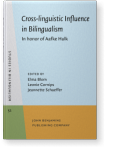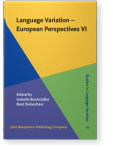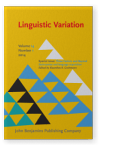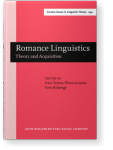Leonie Cornips
List of John Benjamins publications for which Leonie Cornips plays a role.
Journals
The Sociolinguistics of Place and Belonging: Perspectives from the margins
Edited by Leonie Cornips and Vincent A. de Rooij
[IMPACT: Studies in Language, Culture and Society, 45] 2018. vi, 291 pp.
Subjects Sociolinguistics and Dialectology
Cross-linguistic Influence in Bilingualism: In honor of Aafke Hulk
Edited by Elma Blom, Leonie Cornips and Jeannette Schaeffer
[Studies in Bilingualism, 52] 2017. vi, 358 pp.
Subjects Language acquisition | Multilingualism | Theoretical linguistics
Syntax and Variation: Reconciling the Biological and the Social
Edited by Leonie Cornips and Karen P. Corrigan
[Current Issues in Linguistic Theory, 265] 2005. vi, 312 pp.
Subjects Generative linguistics | Sociolinguistics and Dialectology | Theoretical linguistics
Linguistics in the Netherlands 2004
Edited by Leonie Cornips and Jenny Doetjes
[Linguistics in the Netherlands, 21] 2004. viii, 229 pp.
Subjects Theoretical linguistics
Linguistics in the Netherlands 2003
Edited by Leonie Cornips and Paula Fikkert
[Linguistics in the Netherlands, 20] 2003. viii, 225 pp.
Subjects Theoretical linguistics
2024 Variation in the use of the partitive pronoun ER in regional (Heerlen) standard Dutch Methods for Studying Variation in Partitives, Sleeman, Petra and Anne Tamm (eds.), pp. 262–296 | Article
This paper focuses on the variable use of partitive er in two types of constructions. First, er combined with cardinal numbers like drie ‘three’ and quantifiers like genoeg ‘enough’. Second, er combined with an elliptical noun referring to age and weight. Er should be present in the first case… read more
2024 Posthumanism and pragmatics Handbook of Pragmatics: 27th Annual Installment, Vandenbroucke, Mieke, Jana Declercq, Frank Brisard and Sigurd D’hondt (eds.), pp. 169–185 | Chapter
2024 Studying the detailed work of play using conversation analysis: Three case studies of pig interaction in industrial‑rearing settings Interaction Studies 25:2, pp. 190–217 | Article
This paper seeks to explore what happens when research methods predominantly reserved for the human animal are applied to study behavior of other animals. Specifically, we apply conversation analysis to investigate play fighting behavior of piglets in intensive rearing conditions through three… read more
2021 Renewing the coal mining past: Parody, languageculture , and the transformation of cultural memory in Heerlen, the Netherlands International Journal of Language and Culture 8:2, pp. 267–296 | Article
This article examines how inhabitants of Heerlen, a town in the province of Limburg in the southeast of the Netherlands, renew the cultural memory of coal mining in the area through parodic linguistic and cultural practices linked to the (re)articulation of collective local and social identities. read more
2020 Sociolinguistic enregisterment through languagecultural practices Advances in Contact Linguistics: In honour of Pieter Muysken, Smith, Norval, Tonjes Veenstra and Enoch O. Aboh (eds.), pp. 341–364 | Chapter
This chapter will explore the effects of the sociolinguistic enregisterment of Heerlen Dutch in the carnivalesque summer song Naar Talië/Naar Talia ‘To (I)taly’, performed and uploaded onto YouTube by a band called the Getske Boys. The Getske Boys is a group of three male performers who, by… read more
2019 The final frontier: Non-human animals on the linguistic research agenda Linguistics in the Netherlands 2019, Berns, Janine and Elena Tribushinina (eds.), pp. 13–19 | Article
2018 Chapter 4. Cité Duits: A polyethnic miners’ variety The Sociolinguistics of Place and Belonging: Perspectives from the margins, Cornips, Leonie and Vincent A. de Rooij (eds.), pp. 55–88 | Chapter
In the late 1930s and 1940s, locally born children of immigrant coal miners in Tuinwijk, a neighborhood in the village of Eisden in Belgian Limburg, developed a way of speaking among themselves which they later labelled Cité Duits. Having become coal miners themselves, they continued to use Cité… read more
2018 Chapter 2. Bilingual child acquisition through the lens of sociolinguistic approaches Bilingual Cognition and Language: The state of the science across its subfields, Miller, David, Fatih Bayram, Jason Rothman and Ludovica Serratrice (eds.), pp. 15–36 | Chapter
This paper entails a perspective on bilingual child acquisition through the lens of sociolinguistic approaches. A discussion of the concepts of monolingual language ideology and power dynamics is undertaken in order to reveal their important consequences on studying bilingual child acquisition, in… read more
2018 Chapter 1. Introduction: Belonging through linguistic place-making in center-periphery constellations The Sociolinguistics of Place and Belonging: Perspectives from the margins, Cornips, Leonie and Vincent A. de Rooij (eds.), pp. 1–14 | Chapter
2017 Cross-linguistic influence in bilingualism: Festschrift for Aafke Hulk Cross-linguistic Influence in Bilingualism: In honor of Aafke Hulk, Blom, Elma, Leonie Cornips and Jeannette Schaeffer (eds.), pp. 1–14 | Chapter
2017 Chapter 4. Child acquisition of sociolinguistic variation: Adults, children and (regional) standard Dutch two-verb clusters in one community Acquiring Sociolinguistic Variation, De Vogelaer, Gunther and Matthias Katerbow (eds.), pp. 91–116 | Chapter
The main questions of this paper are whether children acquire adults’ variable V1-V2/V2-V1 word order in the perfective two-verb cluster simultaneously with a rigid V1-V2 word order in the modal two-verb cluster from start of the acquisition process. The experimental results show that children… read more
2017 Comparative studies of variation in the use of grammatical gender in the Danish and Dutch DP in the speech of youngsters: Free versus bound morphemes Cross-linguistic Influence in Bilingualism: In honor of Aafke Hulk, Blom, Elma, Leonie Cornips and Jeannette Schaeffer (eds.), pp. 101–126 | Chapter
The paper reports on a cross-linguistic study on speech data produced by monolingual and bilingual Dutch and Danish teenagers. The prediction that both monolingual and bilingual Danish youngsters show less variation in grammatical gender due to more morphological input cues for gender in Danish… read more
2017 Inter-individual variation among young children growing up in a bidialectal community: The acquisition of dialect and standard Dutch vocabulary Language Variation - European Perspectives VI: Selected papers from the Eighth International Conference on Language Variation in Europe (ICLaVE 8), Leipzig, May 2015, Buchstaller, Isabelle and Beat Siebenhaar (eds.), pp. 85–98 | Chapter
This study focuses on the relationship between dialect use and the acquisition of standard Dutch vocabulary by young children in the Dutch province of Limburg.1 The results of a newly-developed dialect expressive vocabulary task show extensive inter-individual variation that does not support a… read more
2017 Regional languages on Twitter: A comparative study between Frisian and Limburgish Dutch Journal of Applied Linguistics 6:2, pp. 174–196 | Article
This paper addressed the question how the use of Dutch and the regional languages Frisian or Limburgish differ on Twitter and which patterns in language choice can be identified. Previous quantitative studies (Jongbloed-Faber, Van de Velde, Van der Meer & Klinkenberg, 2016; Nguyen, Trieschnigg &… read more
2014 Socio-syntax and variation in acquisition: Problematizing monolingual and bidialectal acquisition Three Factors and Beyond: Socio-syntax and language acquisition, Grohmann, Kleanthes K. (ed.), pp. 1–25 | Article
This paper has two aims:* first, to emphasize how the linguistic input to which children are exposed is inherently variable and complex. To this end, we will discuss two particular phenomena in Dutch, namely Aux+Inf and gender marking in DP’s. These phenomena lend themselves to a comparison in… read more
2014 Language contact, linguistic variability and the construction of local identities The Sociolinguistics of Grammar, Åfarli, Tor A. and Brit Mæhlum (eds.), pp. 67–90 | Article
This paper focuses on “old” bidialectal and “new” bilingual language contact settings in the Netherlands combining insights from theoretical linguistics and sociolinguistics. It highlights some surprising conditions for language variation, namely the observation that in the bidialectal contact… read more
2013 Late language acquisition and identity construction: Variation in use of the Dutch definite determiners de and het Language Variation - European Perspectives IV: Selected papers from the Sixth International Conference on Language Variation in Europe (ICLaVE 6), Freiburg, June 2011, Auer, Peter, Javier Caro Reina and Göz Kaufmann (eds.), pp. 57–68 | Article
Aacquisition of the grammatical gender of the Dutch definite common determiner de and neuter het is a long-lasting process since monolingual children do not acquire a target grammar with respect to the use of het until the age of six. Before that age, they overuse de. Bilingual child acquirers from… read more
2013 Selfing and othering through categories of race, place, and language among minority youths in Rotterdam, The Netherlands Multilingualism and Language Diversity in Urban Areas: Acquisition, identities, space, education, Siemund, Peter, Ingrid Gogolin, Monika Edith Schulz and Julia Davydova (eds.), pp. 129–164 | Article
This is the first study of processes of selfing and othering by speakers of a non-standard variety of Dutch. The group studied consists of young men in the Dutch city of Rotterdam who self-identify as Surinamese while having only very limited proficiency in what is considered their heritage… read more
2012 Carnavalesk taalgebruik en de constructie van lokale identiteiten: Een pleidooi voor taalcultuur als onderzoeksveld Dutch Journal of Applied Linguistics 1:1, pp. 15–40 | Article
This article aims to encourage the interdisciplinary study of ‘languaculture,’ an approach to language and culture in which ideology, linguistic and cultural forms, as well as praxis are studied in relation to one another. An integrated analysis of the selection of linguistic and cultural elements… read more
2012
Dutch nouns are divided into two groups according to grammatical gender which is, among others, marked on the definite determiner: common nouns take the definite determiner de and neuter nouns take the definite determiner het. This study is unique in systematically investigating the acquisition of… read more
2008 Misrepresentation of Dutch neuter gender in older bilingual children? Current Trends in Child Second Language Acquisition: A generative perspective, Haznedar, Belma and Elena Gavruseva (eds.), pp. 83–96 | Article
Previous research revealed that monolingual children between 11- and 13-yearold show a target-like production with respect to gender assignment of definite determiners whereas this is not the case for bilingual children who massively overgeneralize de. In order to further investigate this… read more
2006 External and internal factors in billingual and bidialectal language development: Grammatical gender of the Dutch definite determiner L2 Acquisition and Creole Genesis: Dialogues, Lefebvre, Claire, Lydia White and Christine Jourdan (eds.), pp. 355–377 | Article
2006 The acquisition of grammatical gender in bilingual child acquisition of Dutch (by older Moroccan and Turkish children): The definite determiner, attributive adjective and relative pronoun Linguistics in the Netherlands 2006, Weijer, Jeroen van de and Bettelou Los (eds.), pp. 40–51 | Article
2006 Straattaal: Processen van Naamgeving en Stereotypering Thema's en trends in de sociolinguistiek 5, pp. 123–136 | Article
This article shows how dominant negative stereotypical ideas of 'straattaal' and its speakers are constructed and reproduced. The article also shows how, within particular contexts, these ideas may be subject to renegotiation. Data for this article were collected during fieldwork in Amsterdam-East;… read more
2006 Between 2L1- and child L2 acquisition: An experimental study of bilingual Dutch Interfaces in Multilingualism: Acquisition and representation, Lleó, Conxita (ed.), pp. 115–137 | Article
2006 Neuter gender and interface vulnerability in child L2/2L1 Dutch Paths of Development in L1 and L2 acquisition: In honor of Bonnie D. Schwartz, Unsworth, Sharon, Teresa Parodi, Antonella Sorace and Martha Young-Scholten (eds.), pp. 107–134 | Article
2005 Toward an integrated approach to syntactic variation: A retrospective and prospective synopsis Syntax and Variation: Reconciling the Biological and the Social, Cornips, Leonie and Karen P. Corrigan (eds.), pp. 1–27 | Article
2004 Preface Linguistics in the Netherlands 2004, Cornips, Leonie and Jenny Doetjes (eds.), p. | Miscellaneous
2003 Preface Linguistics in the Netherlands 2003, Cornips, Leonie and Paula Fikkert (eds.), p. | Miscellaneous
2003 Acquiring the Syntax of beaucoup at a distance as a Bilingual Child: An Experimental Study Romance Linguistics: Theory and Acquisition, Pérez-Leroux, Ana Teresa and Yves Roberge (eds.), pp. 299–316 | Article
2001 Elicitation techniques in a Dutch syntactic dialect atlas project Linguistics in the Netherlands 2001, Wouden, Ton van der and Hans Broekhuis (eds.), pp. 53–63 | Article
2000 The use of gaan+infinitive in narratives of older bilingual children of Moroccan and Turkish descent Linguistics in the Netherlands 2000, Hoop, Helen de and Ton van der Wouden (eds.), pp. 57–67 | Article
1998 Affected Objects in Heerlen Dutch and Romance Languages in Contrast 1:2, pp. 191–210 | Article
In this paper we show that the well known definition of affected object — as an object that is somehow altered or modified by the action expressed by the verb — is problematic with respect to middle formation, which has been claimed in the literature to be possible only with affected objects. The… read more
1996 Inalienable possession in locational constructions: An apparent problem Linguistics in the Netherlands 1996, Cremers, Crit and Marcel den Dikken (eds.), pp. 37–48 | Article
1996 The spread of the reflexive adjunct middle in the Limburg dialects: 1885-1994 Linguistics in the Netherlands 1996, Cremers, Crit and Marcel den Dikken (eds.), pp. 49–60 | Article
1991 Possessive Object Constructions in Heerlens Linguistics in the Netherlands 1991, Drijkoningen, Frank and Ans M.C. van Kemenade (eds.), pp. 21–30 | Article


































